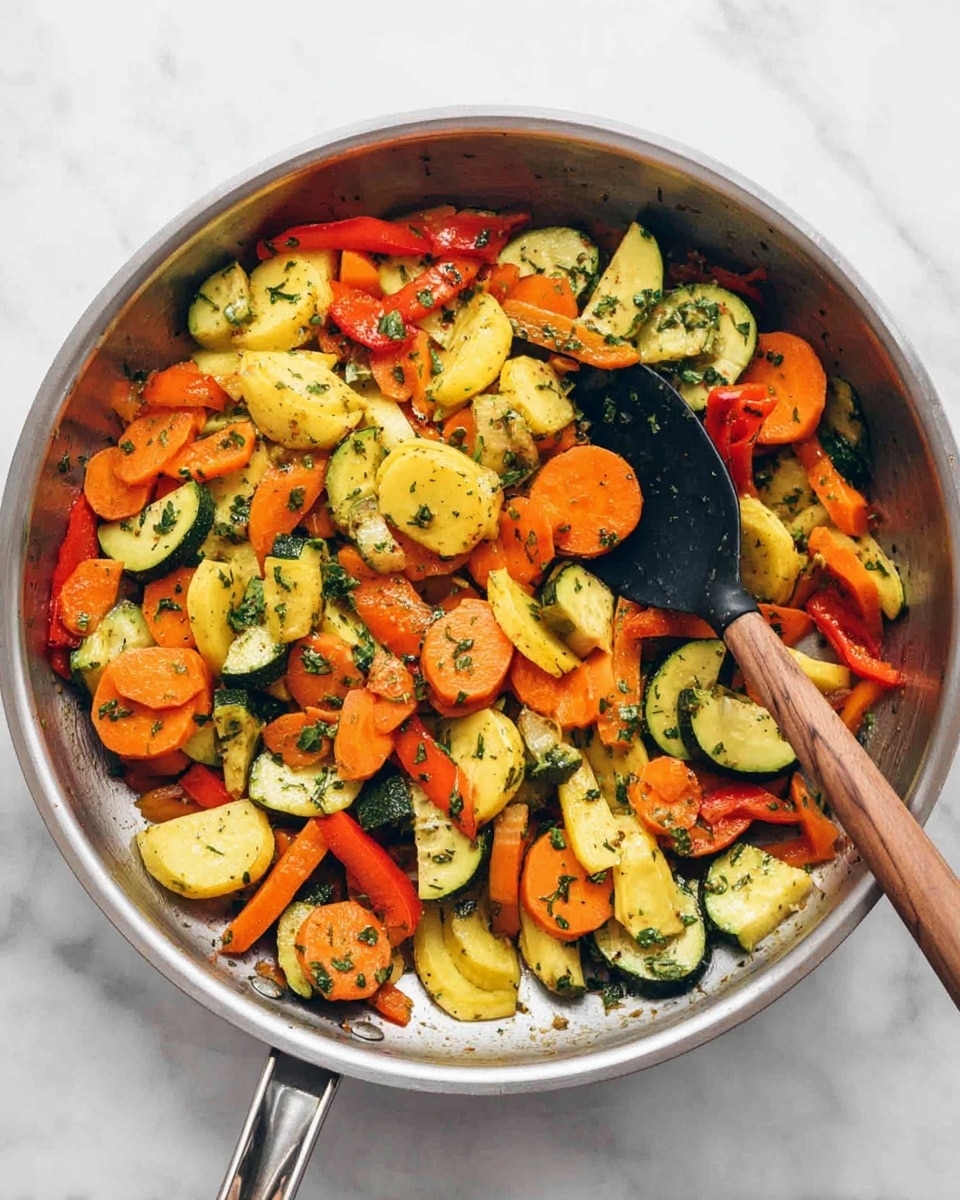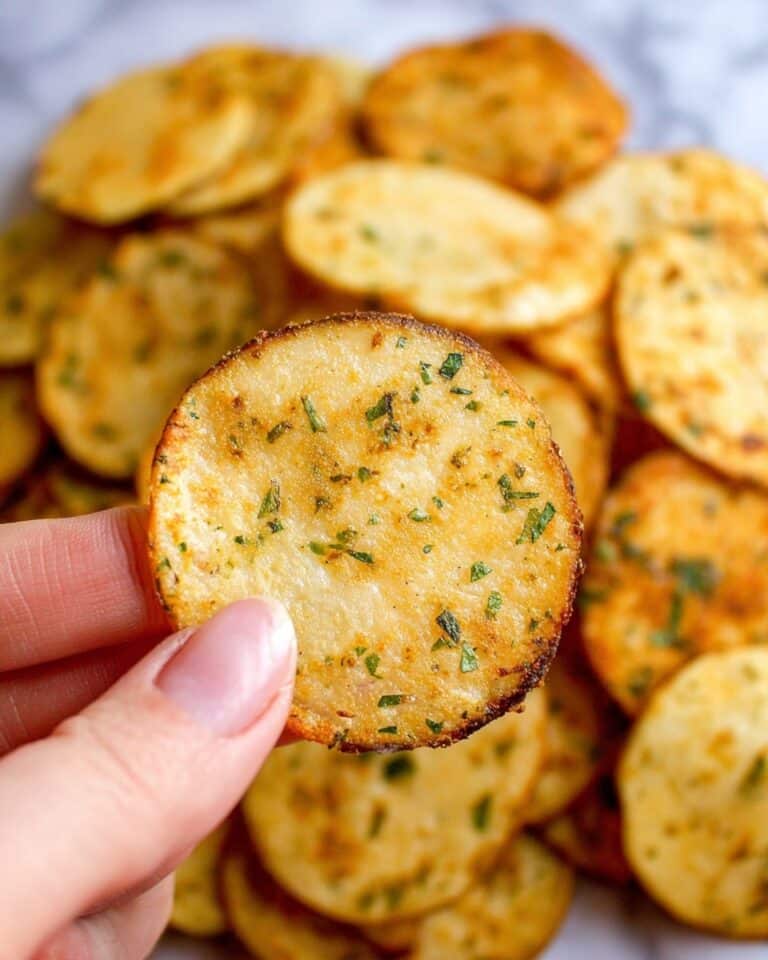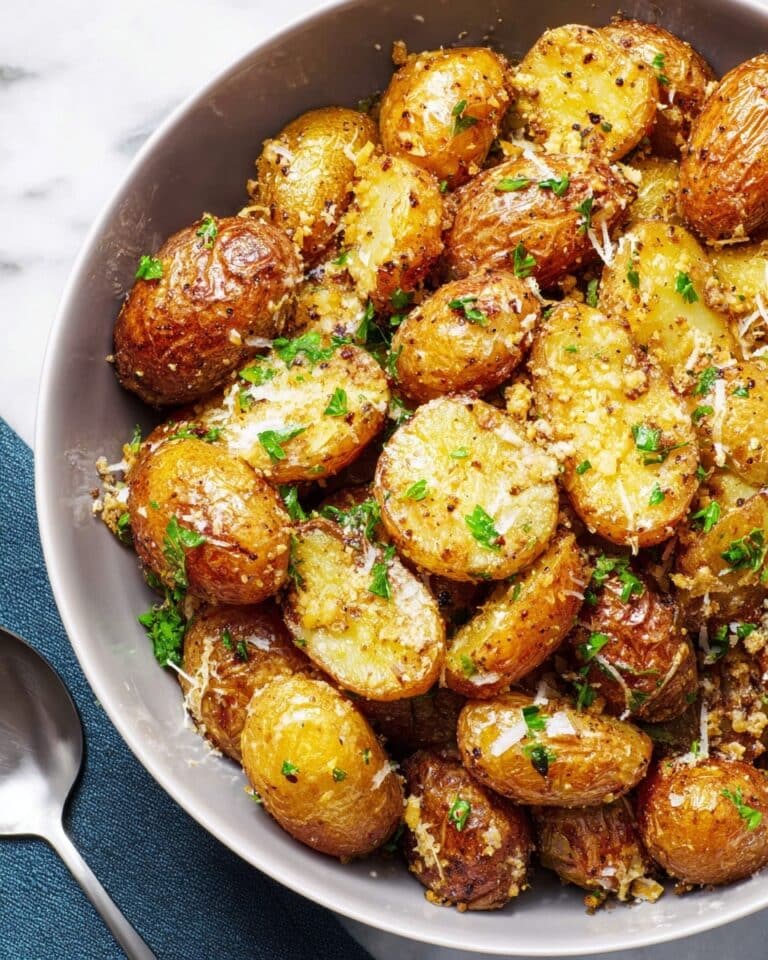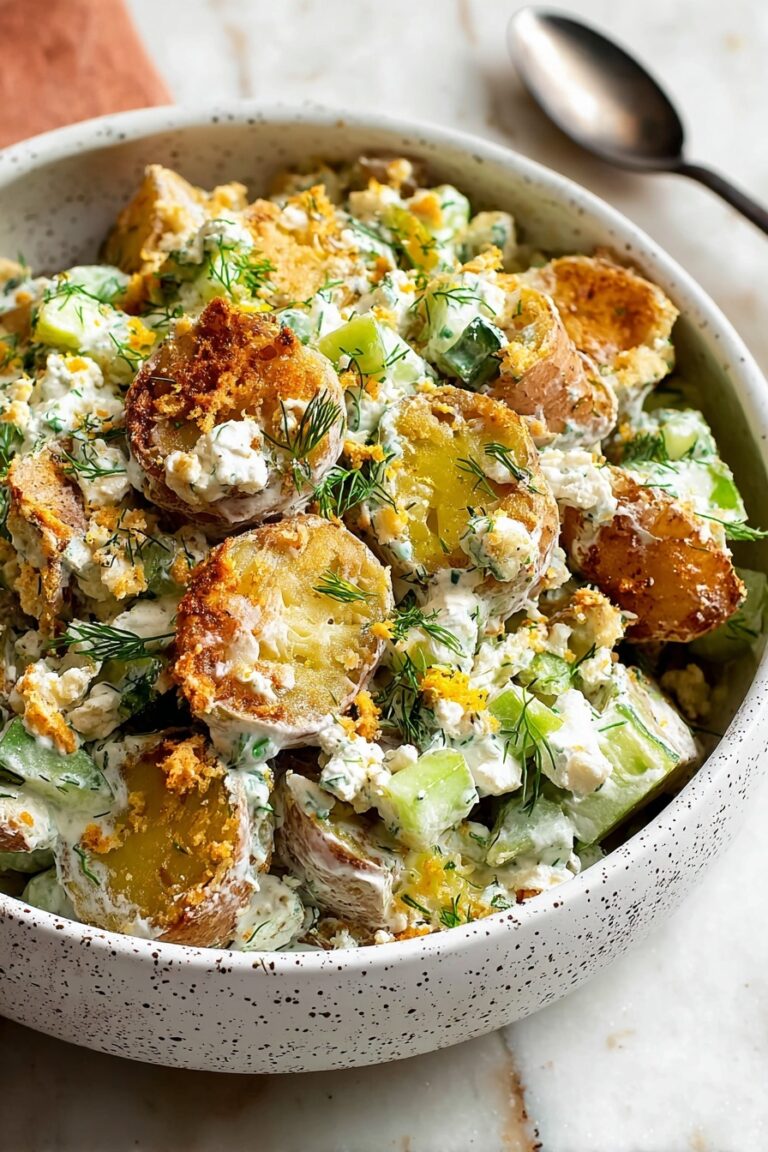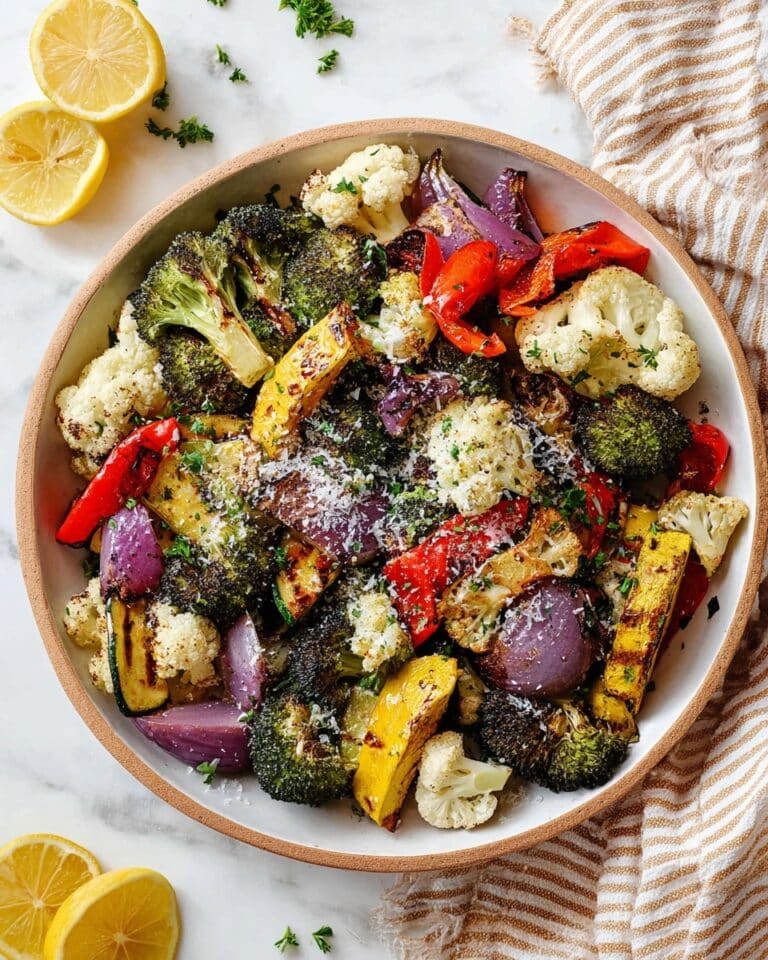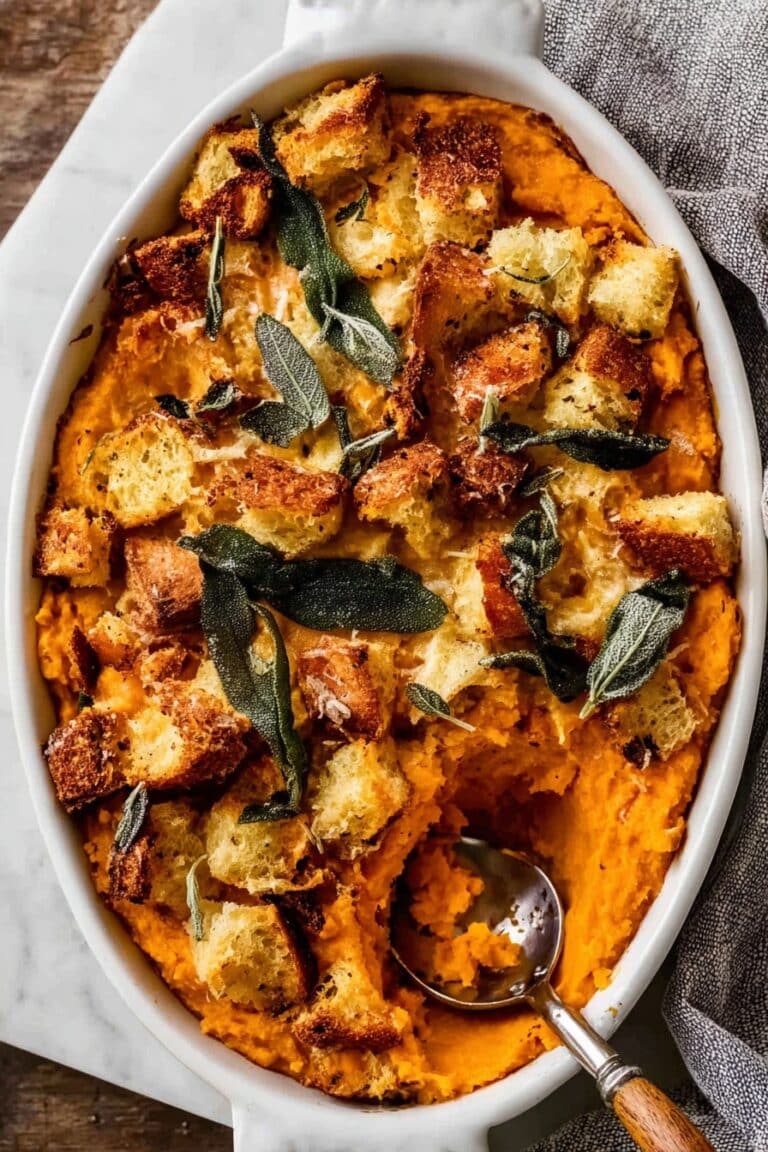Simple Sautéed Vegetables Recipe
If you’re looking for a quick, tasty way to get some colorful veggies on your plate, this Simple Sautéed Vegetables Recipe is a lifesaver. It’s fresh, buttery, and packed with just the right touch of herbs – everything you want when you want a healthy side that doesn’t overcomplicate your kitchen time. I love how this recipe works well any day of the week but especially shines when you want something fast yet satisfying.
What makes this Simple Sautéed Vegetables Recipe really special is how forgiving and flexible it is. Whether you’re new to cooking veggies or someone who’s picky about texture, the method helps you achieve that perfect tender-crisp balance. Plus, it’s a fantastic way to turn everyday ingredients into something with a bit of a wow factor, without needing a long list of spices or fancy techniques.
Why This Recipe Works
- Simplicity with Flavor: Uses just a handful of seasonings to highlight the natural freshness of the veggies.
- Quick and Easy: Perfect for weeknights when you want a healthy side but don’t have much time.
- Texture Perfection: Sautéing just until tender-crisp keeps veggies vibrant and appealing.
- Flexible Ingredients: Easy to swap in whatever fresh veggies you have, making it customized to your kitchen.
Ingredients & Why They Work
Each ingredient in this Simple Sautéed Vegetables Recipe plays a key role – from the crunch of carrots to the mild sweetness of bell peppers, working together to deliver balance and color. Choosing fresh vegetables that aren’t too large or too small helps everything cook evenly, so keep that in mind while shopping.
- Carrots: Their natural sweetness and firm texture give the dish body and a satisfying crunch if sautéed properly.
- Zucchini: Adds mild flavor and moisture, helping to keep the vegetables juicy but not soggy.
- Yellow Squash: Similar to zucchini but with a subtle nuttiness, it blends effortlessly with the other veggies.
- Red Bell Pepper: Adds a pop of color and a slight sweetness that brightens the overall dish.
- Cooking Oil: A neutral oil works best to carry the seasonings and help with even cooking without overpowering flavors.
- Dried Basil & Oregano: These classic herbs give depth without overwhelming the simple vegetable flavors.
- Garlic Powder: Offers subtle savory notes, making the veggies taste rounded and tasty.
- Salt & Pepper: Essential seasonings to bring out the natural goodness of the veggies.
- Butter: A finishing touch that adds luxurious richness and helps the seasonings cling perfectly.
- Fresh Parsley: Optional, but lovely for a fresh, herbaceous garnish that lifts the whole dish.
Tweak to Your Taste
I love how easily you can tweak this Simple Sautéed Vegetables Recipe to suit whatever you have in your fridge or your mood. Sometimes I throw in a pinch of red pepper flakes for heat or swap herbs depending on the season—it’s your playground!
- Variation: I often add sliced mushrooms for an earthier flavor and a bit more umami, which makes it heartier as a side or even a light main.
- Seasonal Changes: In the fall, I like to swap zucchini with diced Brussels sprouts or green beans to capture those seasonal vibes.
- Dietary Twists: For a vegan version, simply skip the butter and toss in a splash of good olive oil at the end for richness.
Step-by-Step: How I Make Simple Sautéed Vegetables Recipe
Step 1: Prep the Veggies with Love
I start by peeling and slicing the carrots – thinner is usually better here to ensure they’re tender in just a few minutes. Then, the zucchini and yellow squash get chopped into half-rounds, which helps them cook evenly while still holding their shape. The red bell pepper is sliced thinly to soften just right without losing that lovely fresh snap.
Step 2: Heat Your Skillet Good and Hot
Heating your skillet over medium-high heat is one of those little things that makes a big difference. Once it’s genuinely hot, swirl in your cooking oil—this ensures an even, slick surface so the veggies sauté nicely instead of steaming. Getting this step right means you’ll get a little golden edge on the carrots that adds fantastic flavor.
Step 3: Cook in Stages for Perfect Texture
I toss in the sliced carrots first because they need a couple of minutes to soften up. After about 2–3 minutes, I add the bell pepper, zucchini, and yellow squash along with the dried basil, oregano, and garlic powder. Sauté everything together for another 2–3 minutes—your goal is just to take the raw edge off and keep the veggies vibrant and slightly crisp. You don’t want them mushy, so keep a close eye.
Step 4: Finish with Butter and Seasoning
Once your veggies have softened just a bit, remove the skillet from the heat and toss in a tablespoon of butter. This is my secret to that glossy, cozy finish that makes simple veggies feel special. Stir until the butter melts and coats every bite, then season with salt and freshly cracked pepper. Don’t forget to taste and adjust! A sprinkle of fresh parsley just before serving adds a pop of color and a fresh finish.
Pro Tips for Making Simple Sautéed Vegetables Recipe
- High Heat Matters: Make sure your pan is hot before adding oil so veggies sear quickly without steaming.
- Cut Uniformly: I learned that slicing veggies into similar sizes helps everything cook evenly, avoiding some parts being mushy and others raw.
- Don’t Overcrowd the Pan: Give each piece a little room to cook properly; crowded pans lead to soggy veggies.
- Finish Off the Heat: Adding butter after removing from heat protects the fresh veggie texture and adds a silky finish without burning it.
How to Serve Simple Sautéed Vegetables Recipe
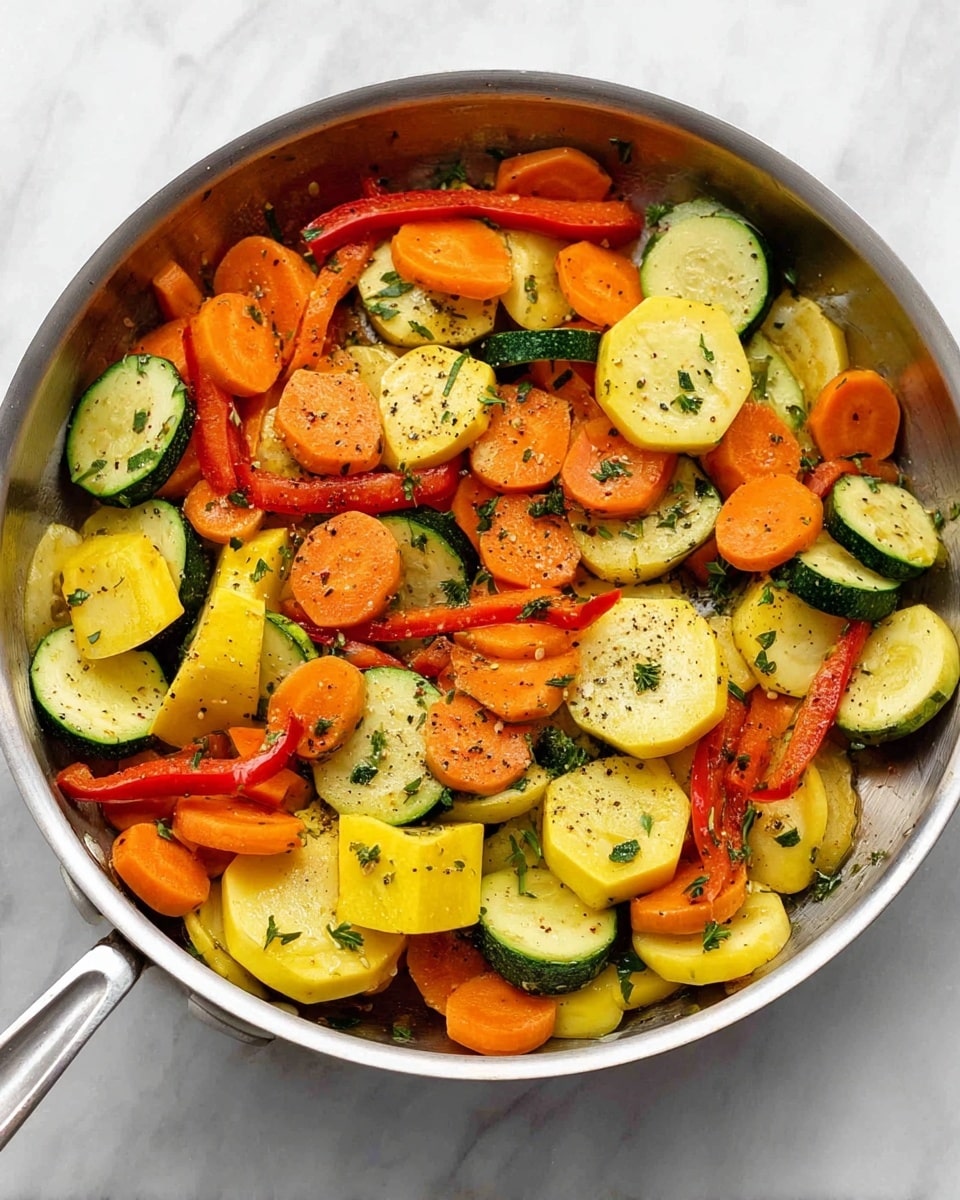
Garnishes
I always top mine with freshly chopped parsley because it adds such a lovely herbal brightness that balances the richness of the butter. Sometimes I’ll sprinkle a little lemon zest for a subtle zing or even a pinch of toasted nuts like pine nuts to add texture and a nutty flavor.
Side Dishes
This Simple Sautéed Vegetables Recipe pairs so well with hearty proteins like grilled chicken or pan-seared salmon. It’s also fantastic alongside a comforting grain dish, like fluffy quinoa or brown rice, rounding out a wholesome meal with ease.
Creative Ways to Present
For special occasions, I like to plate these veggies artfully—either stacked in little towers or arranged in a colorful spiral on the plate. Drizzling a bit of balsamic glaze over top or serving them in a warm bread bowl can turn this humble side into a showstopper with minimal effort.
Make Ahead and Storage
Storing Leftovers
If you have leftovers, I recommend storing them in an airtight container in the fridge for up to 3 days. I usually add a small wipe of butter or a splash of water before reheating so they don’t dry out too much.
Freezing
While I don’t often freeze sautéed vegetables because I prefer their fresh texture, you absolutely can if needed. Just cool them completely before placing in a freezer-safe container. They’ll keep for about 1-2 months but thaw gently to avoid sogginess.
Reheating
The best way I’ve found to reheat this Simple Sautéed Vegetables Recipe is in a hot skillet over medium heat—this helps revive some of that crisp texture without overcooking. Avoid the microwave if you want to keep them from turning mushy.
FAQs
-
Can I use frozen vegetables for this Simple Sautéed Vegetables Recipe?
Yes, but frozen vegetables usually have more moisture, so you’ll want to cook them a little longer and maybe skip adding extra water during cooking. Patting them dry before sautéing helps to prevent sogginess. Fresh veggies, though, always give the best flavor and texture for this recipe.
-
What if I don’t have butter? Can I use all oil?
Absolutely! Using all oil works fine, but butter adds that silky, rich finish that elevates the dish. If you want to keep it dairy-free or vegan, just finish with a drizzle of good-quality olive oil instead.
-
How do I keep my sautéed vegetables from getting mushy?
Cooking on medium-high heat, not overcrowding the pan, and sautéing just until tender-crisp are key steps. Also, cutting the vegetables into uniform pieces helps them cook evenly, so no one gets overdone.
-
Can I add other seasonings to this recipe?
Definitely! Feel free to experiment with your favorite herbs and spices. A pinch of red pepper flakes, a squeeze of fresh lemon juice, or even a splash of soy sauce can add interesting new flavors while keeping the recipe simple and fresh.
Final Thoughts
This Simple Sautéed Vegetables Recipe is one I keep coming back to because it’s straightforward, fast, and always comforting. It’s the kind of side that feels homemade and special without requiring a lot of fuss—perfect for adding a splash of color and nutrition to any meal. I hope you enjoy making it as much as I do; it really feels like giving your veggies a little joyful moment in the spotlight.
Print
Simple Sautéed Vegetables Recipe
- Prep Time: 10 minutes
- Cook Time: 10 minutes
- Total Time: 20 minutes
- Yield: 4 servings
- Category: Side Dish
- Method: Frying
- Cuisine: American
- Diet: Vegetarian
Description
A quick and easy recipe for simple sautéed vegetables featuring carrots, zucchini, yellow squash, and red bell pepper. Lightly seasoned and finished with butter and fresh parsley, this dish makes a perfect healthy side or light meal addition.
Ingredients
Vegetables
- 3 carrots
- 1 zucchini
- 1 yellow squash
- 1/2 red bell pepper
Seasonings and Fats
- 1 tablespoon cooking oil
- 1/4 teaspoon dried basil
- 1/8 teaspoon dried oregano
- 1/8 teaspoon garlic powder
- 1/8 teaspoon salt
- 1/8 teaspoon freshly cracked black pepper
- 1 tablespoon butter
- 1 tablespoon chopped fresh parsley (optional)
Instructions
- Prepare the vegetables: Peel and slice the carrots. Chop the zucchini and yellow squash into half-rounds. Slice the red bell pepper.
- Heat the skillet: Place a skillet over medium-high heat. When hot, add the cooking oil and swirl to coat the surface.
- Sauté carrots: Add the sliced carrots to the skillet and sauté for 3 minutes to start softening.
- Add remaining vegetables and seasonings: Add the bell pepper, zucchini, yellow squash, dried basil, dried oregano, and garlic powder. Continue sautéing for another 3 minutes until vegetables just begin to soften but remain crisp.
- Finish with butter and seasoning: Remove the skillet from heat. Add the butter and toss to melt and coat the vegetables. Season with salt and freshly cracked black pepper to taste.
- Garnish and serve: Sprinkle with fresh chopped parsley if desired and serve immediately.
Notes
- For a vegan version, replace the butter with additional cooking oil or a plant-based butter substitute.
- Adjust seasonings to your preference, adding more herbs or spices as desired.
- Use fresh herbs if available for a brighter flavor.
- Do not overcook the vegetables; they should be tender-crisp to retain texture and nutrients.
Nutrition
- Serving Size: 1 serving
- Calories: 90 kcal
- Sugar: 4 g
- Sodium: 140 mg
- Fat: 5 g
- Saturated Fat: 2 g
- Unsaturated Fat: 3 g
- Trans Fat: 0 g
- Carbohydrates: 10 g
- Fiber: 3 g
- Protein: 1 g
- Cholesterol: 8 mg


